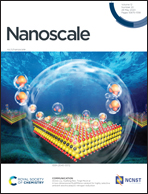Formation and manipulation of domain walls with 2 nm domain periodicity in BaTiO3 without contact electrodes†
Abstract
Interfaces at the two-dimensional limit in oxide materials exhibit a wide span of functionality that differs significantly from the bulk behavior. Among such interfaces, domain walls in ferroelectrics draw special attention because they can be moved deterministically with external voltage, while they remain at place after voltage removal, paving the way to novel neuromorphic and low-power data-processing technologies. Ferroic domains arise to release strain, which depends on material thickness, following Kittel's scaling law. Hence, a major hurdle is to reduce the device footprint for a given thickness, i.e., to form and move high-density domain walls. Here, we used transmission electron microscopy to produce domain walls with periodicity as high as 2 nm without the use of contact electrodes, while observing their formation and dynamics in situ in BaTiO3. Large-area coverage of the engineered domain walls was demonstrated. The domain-wall density was found to increase with increasing effective stress, until arriving at a saturation value that reflects 150-fold effective stress enhancement. Exceeding this value resulted in strain release by domain rotation. In addition to revealing this multiscale strain-releasing mechanism, we offer a device design that allows controllable switching of domain-walls with 2 nm periodicity, reflecting a potential 144 Tb per inch2 neuromorphic network.



 Please wait while we load your content...
Please wait while we load your content...